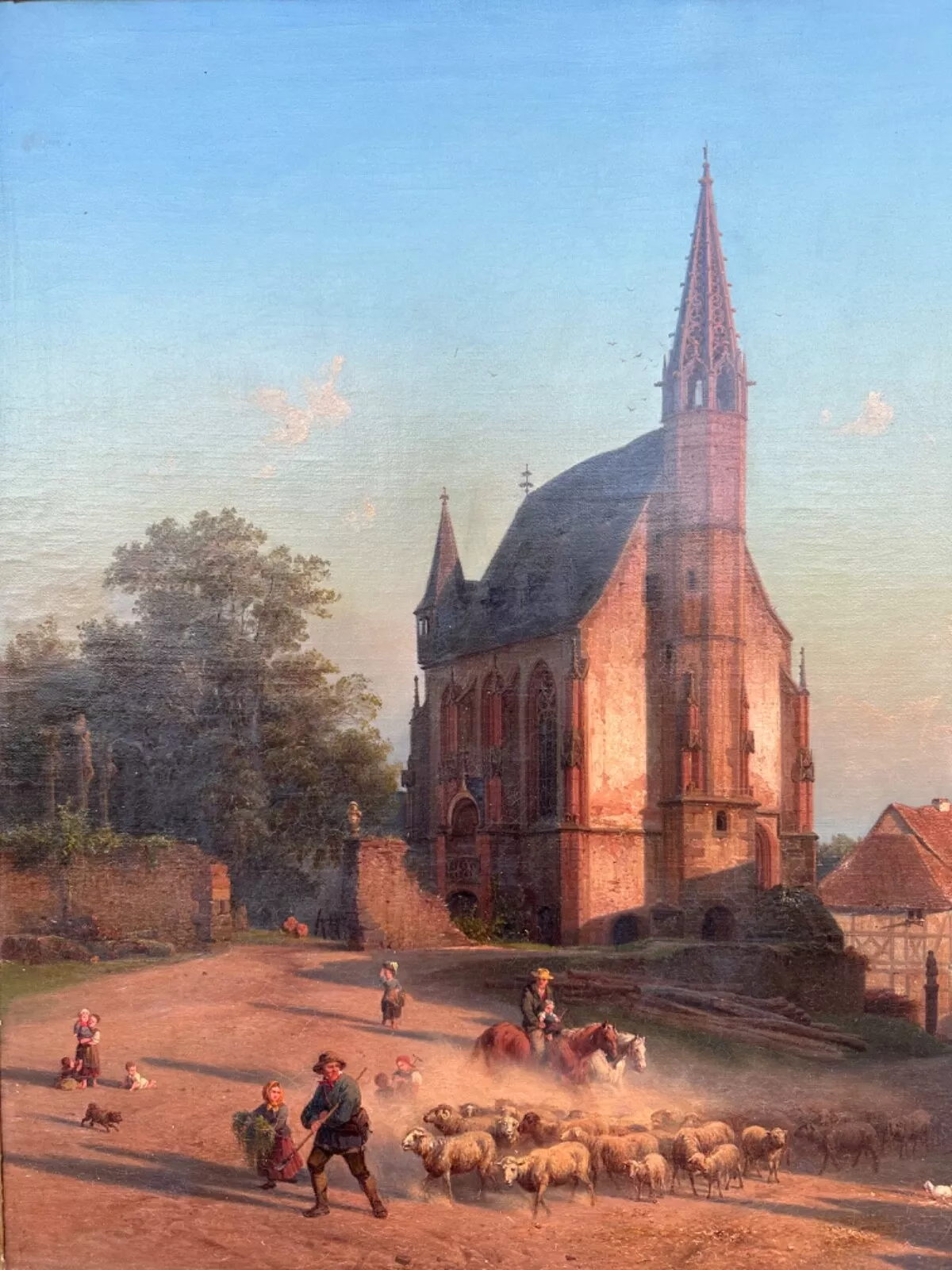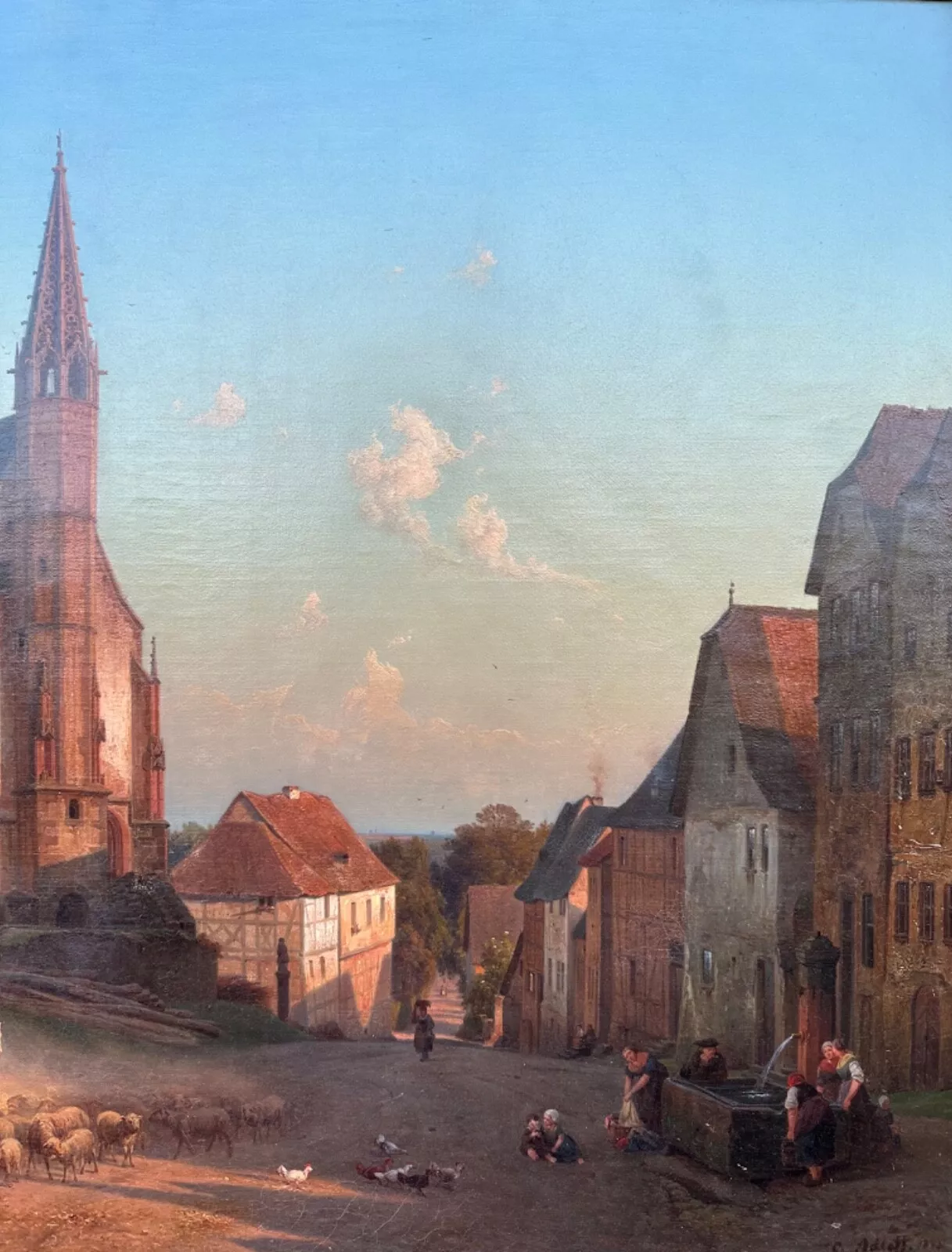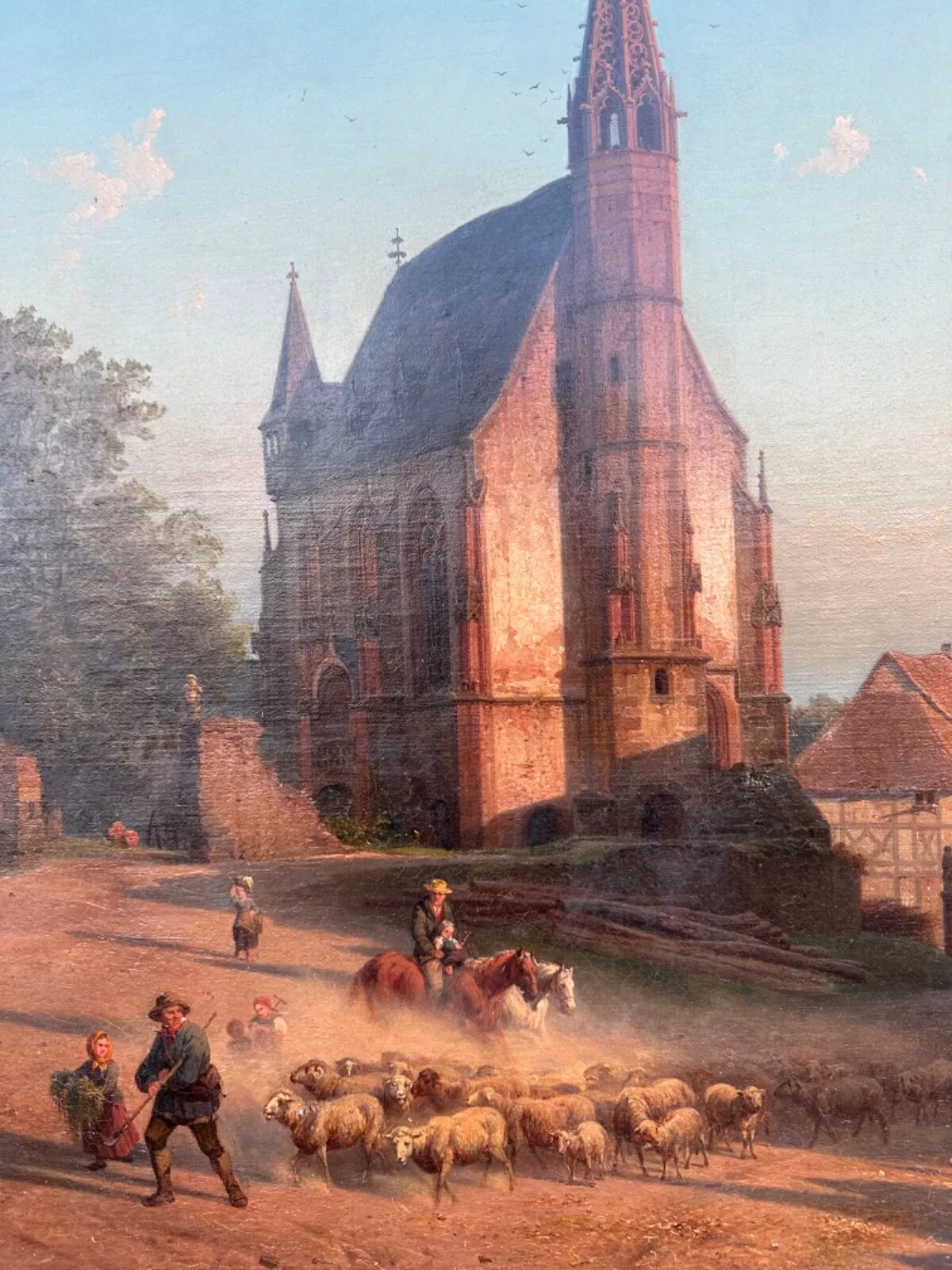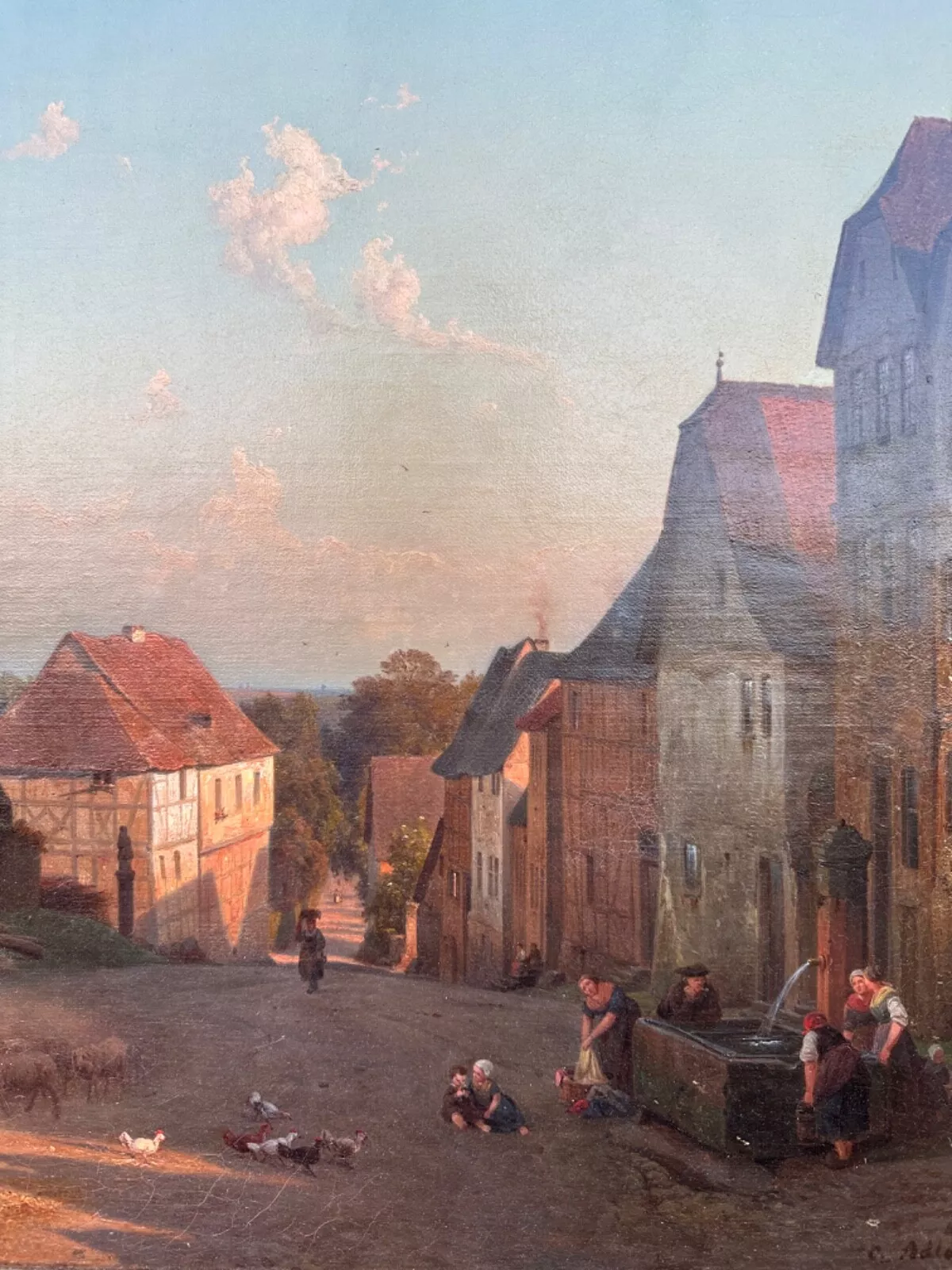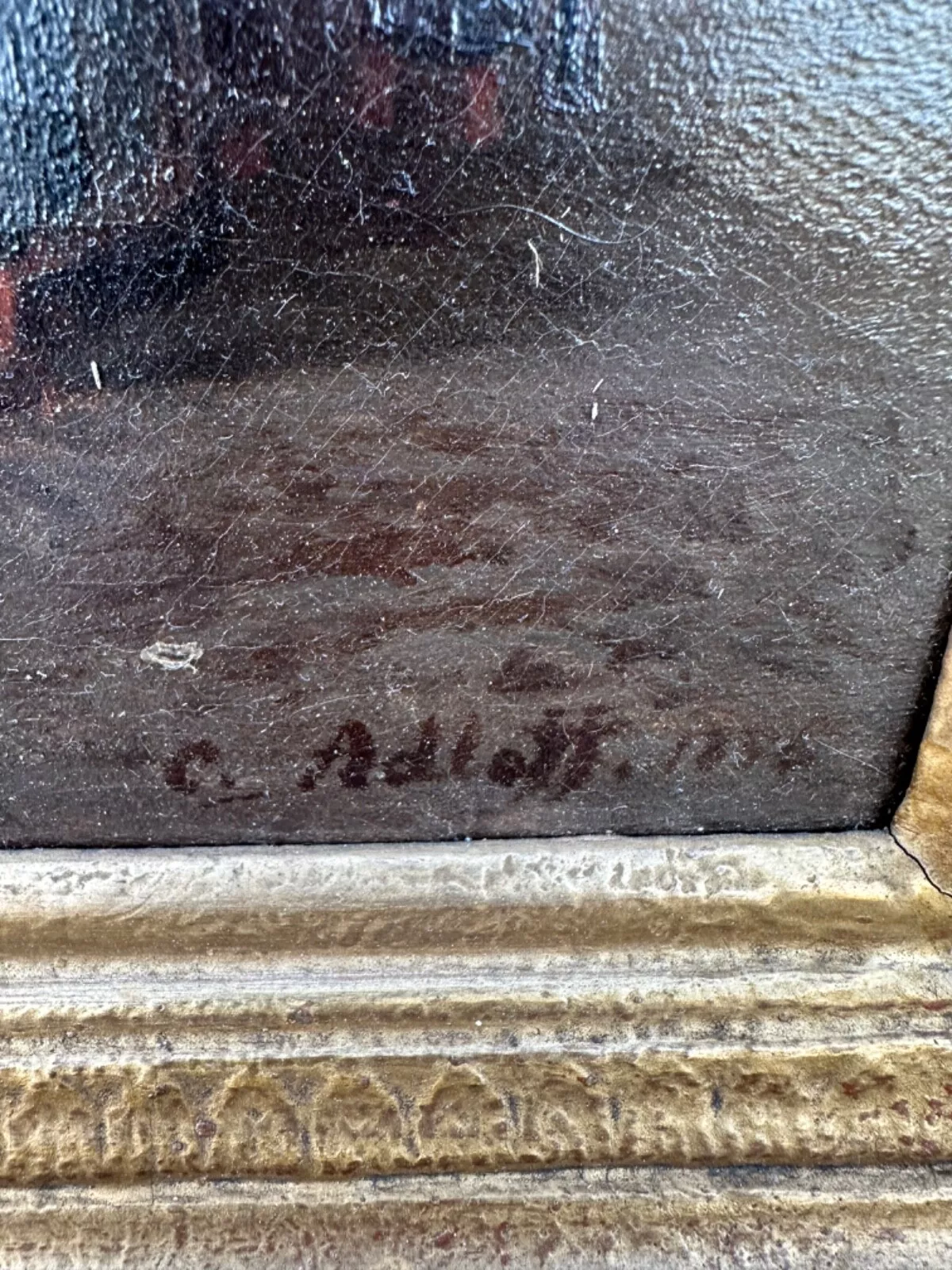View of Kiedrich, signed and dated: “C.Adloff,1856”
Nr. 2638 | 9.800,--Euro
View of Kiedrich
Signed and dated bottom right: “C.Adloff 1856”
Karl Adloff (1819-1863)
Academic painter of the Düsseldorf School
Oil on canvas.
Original contemporary carved and gilded wooden frame.
The Michaelskapelle and shepherds with a flock of sheep in the evening light, riders, farmers, chickens and house scenery.
Provenance: Private collection of the Cologne hotelier Villa
No.: 2638
Height: 118 cm (90) | Width: 100 cm (70) | Depth: 13 cm
Detailed description of the picture by art historian Daniel Leis M.A.
The rectangular image in a beautiful, contemporary frame impresses with the clear and friendly atmosphere of a summer day drawing to a close, with a bright blue sky arching over Kiedrich, bathed in a pleasant warm light by the evening sun. The composition is balanced, the low horizon line is contrasted in a varied way by the buildings on the right side of the image, the group of trees on the left and especially by the towering Michaelskapelle. The church is prominently placed in the image, raised above the foreground, well above the horizon line, its contours are clearly visible in the blue sky. The lighting in the image is also directed towards it. The low evening sun falls on the west facade with its tower. This clearly stands out from the shadowy facades of the houses on the right edge of the image and the darker, green areas of the trees with the crucifixion group on the left edge of the image.
The view can still be easily found in the townscape of Kiedrich today. The course of the street with the square-like extension of the market in the foreground and the buildings on the east side of Marktstrasse are still there, even if the appearance of the houses and the street have changed somewhat. The appearance of St. Michael’s Chapel and the houses on the corner of Marktstrasse and Mühlbergstrasse have not changed. However, the painter Carl Adloff (1819-1863) set his own accents in terms of proportions and accentuation. This is not an exact shot in the sense of a photograph, but a deliberate staging; a prerogative of painting that allows the church to be highlighted by deviating slightly from the actual conditions, without, however, changing the basic arrangement of the topography. The view of the town also serves as a stage for the painter on which he can unfold a story. Not only the location, but also the time of day can be determined by the lighting. It is evening light; The sun, low in the west, is still on the tower of St. Michael’s Chapel, but the shadows have already grown long, those of the houses already cover the market street, where a few people, mainly women, have gathered at the fountain to refresh themselves after the hot and exhausting day in the cool shade as well as in the fresh water from the fountain. The fountain is not only used for fetching water, but also as a meeting place and offers the opportunity for a little chat. The main street of the town, today’s market street, widens in front of the church to form a small square. A flock of sheep is just about to pass through, it came up from the south and passes the scene. Led by a shepherd and a girl with some green fodder, the animals trot in close rows across the dirt road between free-roaming poultry. The dry dust of the road, stirred up by their hooves, accompanies the animals like a small cloud. This detail gives the group dynamism and emphasizes the movement as well as the heat of the passing day. Some children, pausing in their play, watch the action, as does a rider holding a child on his lap.
The entire painting is a homage to Kiedrich and village life, which the painter Carl Adloff painted in 1856. His signature and date can be found on the bottom right of the painting. Carl Adloff was a member of the Düsseldorf School of Painting, where he received his training. He was particularly valued for his ability to capture times of day and their specific lighting moods. The peaceful mood of this painting, the characterization of the evening hour, the evocation of a village idyll, the staging of medieval architecture addressed an audience that was well aware of the idealized depiction, but understood it as romantic. The world shown here was already disappearing at the time the painting was created. Industrialization, technical progress, but also increasing urbanization with its upheavals of old and traditional habits, working methods and social structures were noted and sometimes understood as a threat and loss. In this respect, the changes to the landscape due to road and railway construction, engineering structures such as bridges, and also chimneys as new landmarks and symbols were striking. A kind of countermovement was formed by longings for bygone and apparently perfect times. The landscapes on the Middle Rhine, between Mainz and Koblenz, received particular attention. The image can therefore be reconciled with the Rhine romanticism of that time and with the longing for an idyllic village life. The fact that this time is over may be demonstrated by the church, whose late Gothic architecture refers to times gone by, while the ruined surrounding wall represents their passing.
The St. Michael’s Chapel in Kiedrich
The Michael’s Chapel is a listed Gothic church building dating from the first half of the 15th century in Kiedrich in the Rheingau region of Hesse. It is located in the church precinct of the Catholic parish church of St. Valentinus and Dionysius and is considered the “architecturally richest and artistically noblest example of this type of building in the present-day state of Hesse”. (Source: Wikipedia)
Karl Adloff 1819-1863
The painter Karl Adloff was the child of Franz Joseph Adloff (1786-1832) and Anna Margaretha Adloff, née Kaimer (1784-1846).
From 1833 to 1843 he studied at the Düsseldorf Art Academy, where he attended the landscape painting class under Johann Wilhelm Schirmer in 1836 and the architecture class under Rudolf Wiegmann in 1840/1841. In the student lists of the master class from 1840 to 1843 he was listed as an architecture and landscape painter.
In his choice of motifs he preferred the Dutch landscape, in keeping with Dutch painting of the 17th century; he created views of beaches, harbors, canals, and cities, capturing the architecture with great detail and a delicate painting style.
He often painted seascapes that were bathed in a romantic atmosphere of calm by the moonlight, morning light, and evening light. He was repeatedly represented at academic art exhibitions in Germany and abroad. Adloff was a member of the Malkasten artists’ association. Adloff married Adelheid Schmitz (1820–1893); their marriage produced a daughter, Sybilla Carolina (1850–1927).
They lived at Pfannenschoppenstrasse 239 (now Klosterstrasse in Düsseldorf city center) – in the house where Alwine and Adolph Schroedter had lived before they went to Karlsruhe. In 1868, Sybilla Carolina became the wife of the animal painter Carl Jutz the Elder[4] and in 1873 the mother of the later landscape painter Carl Jutz the Younger. Adloff was buried in the Golzheim Cemetery (southern part).
Biedermeier at RSA Wiesbaden
You can find a wide selection of Biedermeier furniture and decorative art pieces.
Regine Schmitz-Avila – your Biedermeier specialist for cabinets, tables, and chests.


